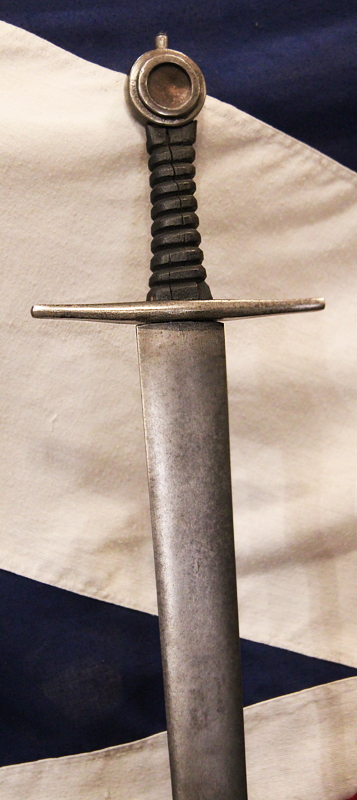19th Century 'Historismus' Crusader's 'Knightly' Sword, In The 12th to 13th Century Style
Typical cruciform hilt with circular wheel pommel. In the early 19th century Sir Walter Scott's novels created a great resurgence in the interest in romantic knightly tales of derring do and chivalry, and this was strongly followed in architecture at the time. To reflect the huge interest, numerous great castles and gothic mansions were built, and many were furnished with historismus knightly armour and weaponry such as this, made in the medieval style. The Crusades were a series of religious wars sanctioned by the Latin Church in the medieval period. The most commonly known Crusades are the campaigns in the Eastern Mediterranean aimed at recovering the Holy Land from Muslim rule, but the term "Crusades" is also applied to other church-sanctioned campaigns. These were fought for a variety of reasons including the suppression of paganism and heresy, the resolution of conflict among rival Roman Catholic groups, or for political and territorial advantage. At the time of the early Crusades the word did not exist, only becoming the leading descriptive term around 1760.
In 1095, Pope Urban II called for the First Crusade in a sermon at the Council of Clermont. He encouraged military support for the Byzantine Empire and its Emperor, Alexios I, who needed reinforcements for his conflict with westward migrating Turks colonizing Anatolia. One of Urban's aims was to guarantee pilgrims access to the Eastern Mediterranean holy sites that were under Muslim control but scholars disagree as to whether this was the primary motive for Urban or those who heeded his call. Urban's strategy may have been to unite the Eastern and Western branches of Christendom, which had been divided since the East?West Schism of 1054 and to establish himself as head of the unified Church. The initial success of the Crusade established the first four Crusader states in the Eastern Mediterranean: the County of Edessa, the Principality of Antioch, the Kingdom of Jerusalem and the County of Tripoli. The enthusiastic response to Urban's preaching from all classes in Western Europe established a precedent for other Crusades. Volunteers became Crusaders by taking a public vow and receiving plenary indulgences from the Church. Some were hoping for a mass ascension into heaven at Jerusalem or God's forgiveness for all their sins. Others participated to satisfy feudal obligations, obtain glory and honour or to seek economic and political gain. We don't normally acquire or sell non original items but historismus pieces have always been desireable and most collectable in their own right. Historicism or also historism and historismus comprises artistic styles that draw their inspiration from recreating historic styles or imitating the work of historic artisans. This is especially prevalent in architecture, such as revival architecture. Through a combination of different styles or implementation of new elements, historicism can create completely different aesthetics than former styles. Thus it offers a great variety of possible designs.
In the history of art, after Neoclassicism which in the Romantic era could itself be considered a historicist movement, the 19th century saw a new historicist phase marked by an interpretation not only of Greek and Roman classicism, but also of succeeding stylistic eras, which were increasingly considered equivalent. In particular in architecture and in the genre of history painting, in which historical subjects were treated of with great attention to accurate period detail, the global influence of historicism was especially strong from the 1850s onwards. The change is often related to the rise of the bourgeoisie during and after the Industrial Revolution.
Code: 22200







